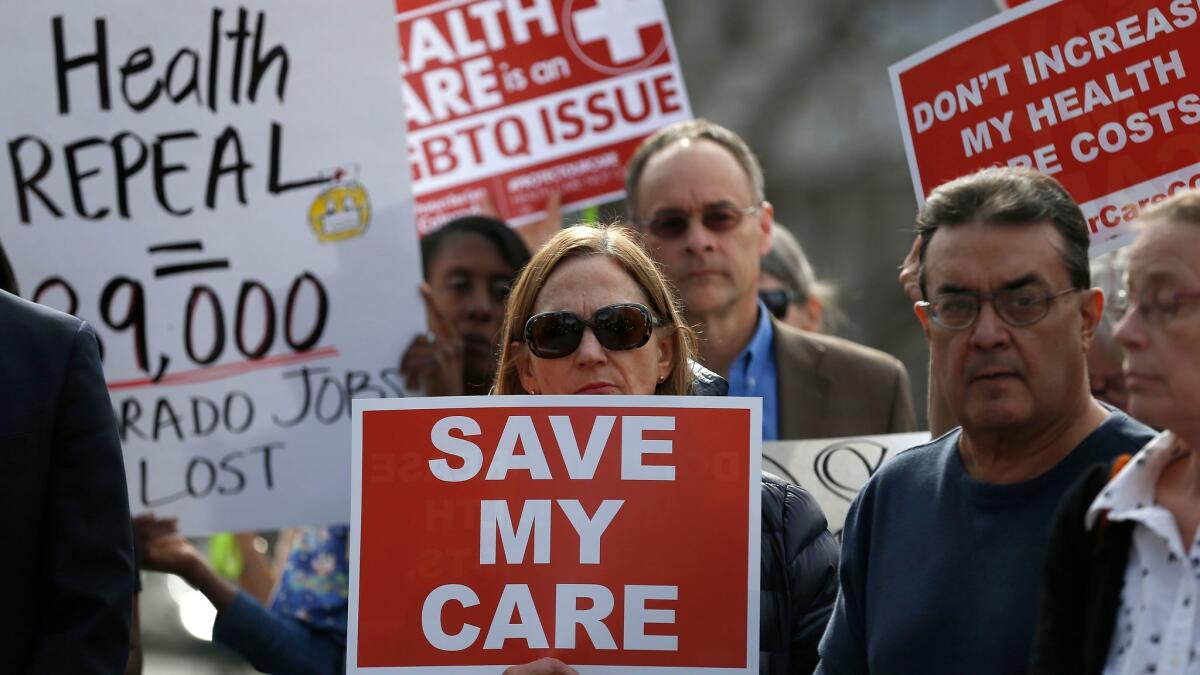Opinion: Trump tries to save Obamacare exchanges while undermining them

- Share via
With the drive to “repeal and replace” Obamacare losing steam, the Trump administration quietly moved to shore up a key feature of the healthcare law this week: the state exchanges where people shop for non-group coverage. And to its credit, Trump’s Department of Health and Human Services zeroed in on some of the factors that have led a handful of major insurers to leave the exchanges.
But before you praise (or condemn) Trump for coming to Obamacare’s rescue, consider this: Another arm of the new administration has taken a step that could undo much of the work the department is trying to do, and leave the exchanges no better off — and possibly in worse shape — than they are today.
The real threat to the exchanges’ health remains the specter of Congress enacting a law that repeals all or part of Obamacare in two or three years. Planting such a legislative time bomb would have an immediate impact, sending the market for non-group insurance policies quickly into chaos, according to analysts from both sides of the political spectrum. As John Rother of the pro-Obamacare National Coalition on Health Care put it, “[N]o market stabilization effort can succeed if policymakers disrupt existing coverage arrangements rather than improving on them.”
The proposal looks at the issue mainly from insurers’ point of view, aiming to reduce their costs without increasing the value of their policies to consumers
A core problem for the exchanges, which serve people not covered by a large employer’s group health plan, is that the people shopping there are running up larger healthcare bills than insurers expected. That’s resulted in losses for many insurers, persuading some to withdraw from the market and others to jack up premiums sharply.
Some critics argue that these trends are signs of Obamacare’s impending doom; the law’s supporters say they’re just growing pains, and there’s still plenty of evidence that the exchanges are sustainable (albeit with some adjustments). California’s experience is a case in point — its exchange, Covered California, still offers shoppers two or more options in every region, and its premium increases have been modest compared to the rest of the country’s.
Both sides in the debate agree that the exchanges need a balanced risk pool — that is, they need to attract healthy customers as well as sick ones. There are many pieces to that puzzle, ranging from how the exchanges are marketed to how expensive the policies are. The proposed rule from HHS looks at the issue mainly from insurers’ point of view, aiming to reduce their costs without increasing the value of their policies to consumers.
Specifically, the proposal would deter people from dropping coverage when they don’t need treatment; let insurers offer provider networks with fewer doctors that treat low-income or underserved areas; and allow insurers to offer policies that cover a smaller percentage of a consumer’s medical bills than the law previously required — without clearly alerting consumers to the change.
Talk about a win for consumers! OK, so maybe it sounds more like an eat-your-vegetables prescription than a here’s-more-candy approach. But the enforcement mechanisms in the 2010 Patient Protection and Affordable Care Act were too weak to persuade many younger, healthier Americans to sign up for insurance, as the law required (the infamous “individual mandate”). And the Obama administration only made matters worse with its early rules and guidance (although its approach started to change late in the Obama presidency). The Trump administration’s proposed rule may be too heavily weighted on penalizing people who don’t obtain coverage when they should, but that sort of discipline was overdue.
But again, there’s a left-hand-vs.-right-hand thing going on within the Trump administration. Earlier this month, the Internal Revenue Service undermined the only real enforcement mechanism behind the individual mandate: the tax penalty for Americans who go a month or more without coverage. The IRS decided that it won’t require taxpayers to reveal whether they carried insurance in 2016, reversing its previous stance. Thus, the penalty will apply only to those taxpayers who rat themselves out voluntarily.
In light of the IRS’ move, the proposed HHS rule seems like cold comfort to insurers worried about the exchanges’ risk pools. And HHS’ proposal wasn’t much of a silver bullet to start with. According to the department, the changes it proposed could lead to lower costs for insurers and, potentially, lower premiums, attracting more healthy people to the exchanges. But it acknowledged that the opposite could happen too, depending on how insurers and consumers responded to the changes. “The net effect of these proposed provisions on enrollment, premiums and total premium tax credit payments [is] ambiguous,” the department concluded.
Twitter: @jcahealey
More to Read
A cure for the common opinion
Get thought-provoking perspectives with our weekly newsletter.
You may occasionally receive promotional content from the Los Angeles Times.







